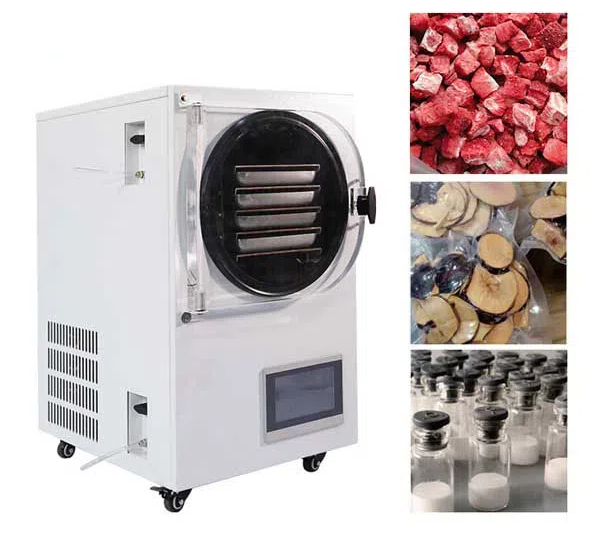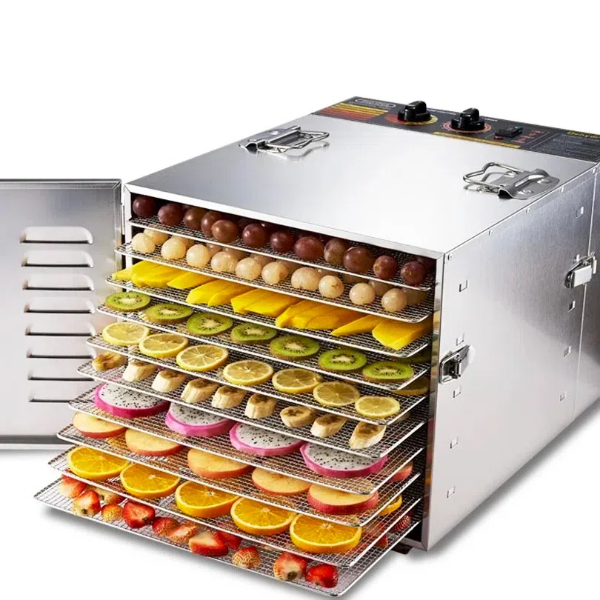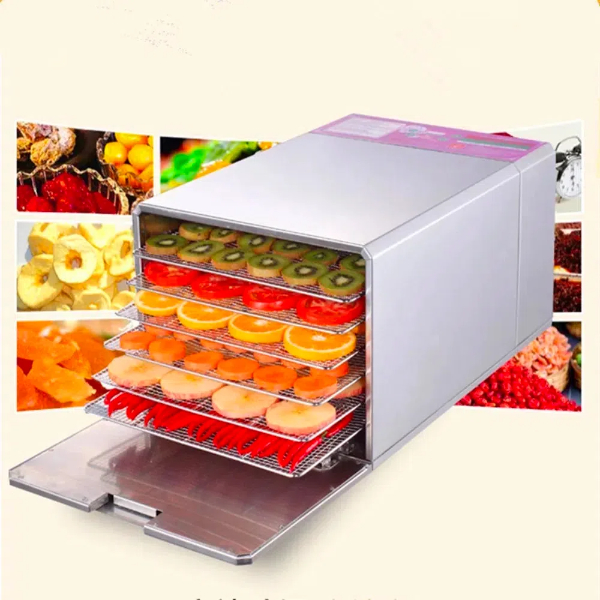
Content Menu
● Introduction
● What is a Dried Food Machine?
>> How Does a Dried Food Machine Work?
● Types of Dried Food Machines
>> 1. Home Food Dehydrators
>> 2. Commercial Food Dehydrators
>> 3. Industrial Food Drying Systems
>> 4. Freeze-Dried Food Machines
● Applications of Dried Food Machines
>> 1. Fruit and Vegetable Preservation
>> 2. Meat Processing
>> 3. Herb and Spice Drying
>> 4. Pet Food Production
>> 5. Backpacking and Camping Food
● Benefits of Using a Dried Food Machine
● Choosing the Right Dried Food Machine
>> 1. Capacity
>> 2. Temperature Control
>> 3. Air Flow
>> 4. Tray Material
>> 5. Noise Level
>> 6. Energy Efficiency
● Tips for Using Your Dried Food Machine
● Innovative Uses for Dried Food Machines
● The Future of Dried Food Machines
● Conclusion
● Frequently Asked Questions
>> 1. What is the difference between a food dehydrator and a freeze-dried food machine?
>> 2. How long does it take to dry food in a dried food machine?
>> 3. Are dried foods as nutritious as fresh foods?
>> 4. Can I use a dried food machine to make pet treats?
>> 5. How do I clean and maintain my dried food machine?
Introduction
In recent years, the popularity of dried food machines has skyrocketed as more people discover the benefits of food dehydration. These versatile appliances, also known as food dehydrators or fruit dryer machines, have become essential tools in both home kitchens and commercial food processing facilities. In this comprehensive guide, we'll explore the world of dried food machines, their various applications, and how they're changing the way we preserve and enjoy our favorite foods.
What is a Dried Food Machine?
A dried food machine, commonly referred to as a food dehydrator, is an appliance designed to remove moisture from food items. This process extends the shelf life of foods while preserving their nutritional value and flavor. These machines come in various sizes and configurations, ranging from small home units to large industrial food drying systems.

How Does a Dried Food Machine Work?
The basic principle behind a dried food machine is simple: it uses a combination of warm air circulation and low humidity to gradually remove moisture from food items. Most food dehydrators consist of the following components:
1. Heating element
2. Fan for air circulation
3. Trays or shelves for holding food
4. Adjustable temperature controls
5. Timer (in some models)
Types of Dried Food Machines
There are several types of dried food machines available on the market, each suited for different purposes and capacities:
1. Home Food Dehydrators
These compact units are perfect for individuals or families who want to make their own dried snacks, herbs, or pet treats. Home food dehydrators typically have multiple trays and can handle small to medium batches of food.
2. Commercial Food Dehydrators
Designed for larger-scale operations, commercial food dehydrators are more powerful and have a higher capacity than home units. These machines are often used in restaurants, health food stores, and small-scale food production facilities.
3. Industrial Food Drying Systems
These large-scale systems are used in food manufacturing plants to process large volumes of dried foods. Industrial food drying systems often incorporate advanced features like precise temperature and humidity controls, automated loading and unloading, and multiple drying chambers.
4. Freeze-Dried Food Machines
Also known as vacuum freeze dryers, these specialized machines use a process called lyophilization to remove moisture from foods. Freeze-dried food machines are capable of preserving the texture, flavor, and nutritional content of foods better than traditional dehydration methods.

Applications of Dried Food Machines
Dried food machines have a wide range of applications across various industries and settings:
1. Fruit and Vegetable Preservation
One of the most common uses for dried food machines is preserving fruits and vegetables. By removing moisture, these machines help extend the shelf life of produce while maintaining its nutritional value. Popular dried fruits include apples, bananas, strawberries, and mangoes, while common dried vegetables include tomatoes, carrots, and bell peppers.
2. Meat Processing
Dried food machines, particularly those designed as jerky makers, are excellent for creating dried meat products. Beef jerky, turkey jerky, and other dried meat snacks can be easily made using these appliances, offering a protein-rich, shelf-stable food option.
3. Herb and Spice Drying
Home gardeners and commercial herb producers alike use dried food machines to preserve fresh herbs and spices. This process helps maintain the flavor and aroma of herbs like basil, oregano, and thyme, allowing for year-round use.
4. Pet Food Production
Many pet owners and small-scale pet food manufacturers use dried food machines to create healthy, preservative-free treats for dogs and cats. These machines can be used to dry meat, fruits, and vegetables for pet consumption.
5. Backpacking and Camping Food
Outdoor enthusiasts often rely on dried foods for their lightweight and long-lasting properties. Dried food machines can be used to create custom trail mixes, dried meals, and snacks for backpacking and camping trips.
Benefits of Using a Dried Food Machine
There are numerous advantages to incorporating a dried food machine into your food preservation routine:
1. Extended shelf life of foods
2. Preservation of nutritional value
3. Reduction of food waste
4. Cost savings on seasonal produce
5. Creation of healthy, additive-free snacks
6. Customization of dried food blends and mixes
7. Space-saving food storage solutions
Choosing the Right Dried Food Machine
When selecting a dried food machine, consider the following factors:
1. Capacity
Determine how much food you plan to dry at once. Home users may be satisfied with a smaller unit, while those planning to dry large quantities should opt for a commercial or industrial-grade machine.
2. Temperature Control
Look for a machine with adjustable temperature settings to accommodate different types of foods. Some foods require lower temperatures for optimal drying, while others may need higher heat.
3. Air Flow
Efficient air circulation is crucial for even drying. Choose a machine with a powerful fan and well-designed air flow system.
4. Tray Material
Stainless steel trays are durable and easy to clean, while plastic trays are lighter and less expensive. Consider your priorities when choosing between these options.
5. Noise Level
Some dried food machines can be noisy during operation. If this is a concern, look for models designed for quiet operation.
6. Energy Efficiency
Consider the energy consumption of the machine, especially if you plan to use it frequently. Look for models with energy-saving features or certifications.
Tips for Using Your Dried Food Machine
To get the most out of your dried food machine, follow these helpful tips:
1. Prepare foods uniformly: Cut fruits and vegetables into even-sized pieces for consistent drying.
2. Pre-treat fruits: Dip sliced fruits in lemon juice or ascorbic acid solution to prevent browning.
3. Use the right temperature: Follow recommended drying temperatures for different food types to ensure safe and effective dehydration.
4. Rotate trays: For even drying, rotate the trays periodically during the drying process.
5. Allow proper air circulation: Avoid overcrowding the trays to ensure adequate air flow around each food item.
6. Check for dryness: Test foods for dryness before removing them from the machine. They should be leathery or crisp, depending on the food type.
7. Store properly: Once dried, store foods in airtight containers in a cool, dark place to maintain freshness.
Innovative Uses for Dried Food Machines
While dried food machines are primarily used for preserving fruits, vegetables, and meats, creative users have found innovative applications for these versatile appliances:
1. Making fruit leathers and roll-ups
2. Creating dried flower arrangements
3. Drying homemade pasta
4. Crafting potpourri and scented sachets
5. Dehydrating seeds for long-term storage
6. Making your own tea blends
7. Creating natural air fresheners
The Future of Dried Food Machines
As technology advances, we can expect to see continued innovations in dried food machine design and functionality. Some potential developments include:
1. Smart features and app integration for remote monitoring and control
2. Improved energy efficiency and sustainability
3. Enhanced preservation techniques to better maintain nutritional value
4. Integration with other kitchen appliances for seamless food preparation and preservation
Conclusion
Dried food machines have revolutionized the way we approach food preservation, offering a convenient and effective method for extending the shelf life of various foods. Whether you're a home cook looking to reduce food waste, an outdoor enthusiast in need of lightweight meal options, or a commercial food producer seeking efficient drying solutions, there's a dried food machine to suit your needs. By understanding the different types of machines available and following best practices for food dehydration, you can unlock a world of culinary possibilities and enjoy the benefits of dried foods year-round.

Frequently Asked Questions
1. What is the difference between a food dehydrator and a freeze-dried food machine?
Answer: A food dehydrator uses warm air circulation to remove moisture from foods, while a freeze-dried food machine (or vacuum freeze dryer) uses a process called lyophilization. Freeze-drying involves freezing the food and then removing the ice through sublimation, resulting in a product that better retains its original texture and nutritional value.
2. How long does it take to dry food in a dried food machine?
Answer: Drying times can vary greatly depending on the type of food, its moisture content, and the specific machine being used. Generally, fruits and vegetables can take anywhere from 6 to 16 hours, while meats may take up to 24 hours or more. Always refer to your machine's manual and recipe guidelines for specific drying times.
3. Are dried foods as nutritious as fresh foods?
Answer: Dried foods retain most of their nutritional value, including fiber, carbohydrates, and minerals. However, some vitamins, particularly vitamin C and some B vitamins, may be lost during the drying process. Overall, dried foods can be a nutritious alternative to fresh foods, especially when fresh options are not available.
4. Can I use a dried food machine to make pet treats?
Answer: Yes, dried food machines are excellent for making homemade pet treats. You can dry meats, fruits, and vegetables to create healthy, preservative-free snacks for dogs and cats. Always ensure that the ingredients you use are safe for pet consumption and consult with your veterinarian if you have any concerns.
5. How do I clean and maintain my dried food machine?
Answer: To clean your dried food machine, first unplug it and allow it to cool completely. Remove the trays and wash them with warm, soapy water. Wipe down the interior and exterior of the machine with a damp cloth. For stubborn residue, use a soft brush or sponge. Avoid using abrasive cleaners or submerging the main unit in water. Regularly check and clean the fan and heating element to ensure optimal performance. Always refer to your machine's manual for specific cleaning and maintenance instructions.












